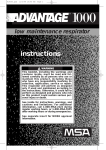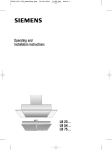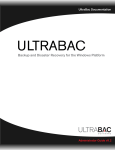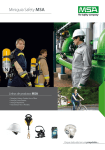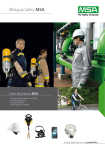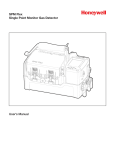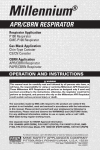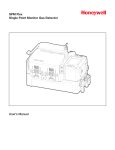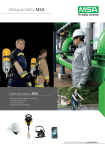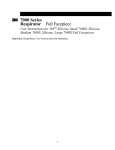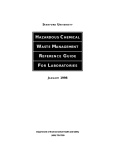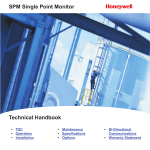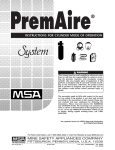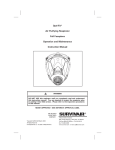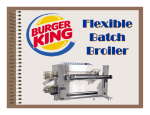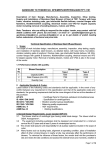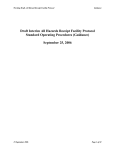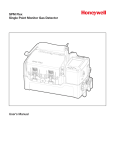Download MSA Optimair HC (Health Care) User Manual
Transcript
OptimAir 6HC ® INSTRUCTIONS Powered Air-Purifying Respirator OptimAir 6HC PAPR with Combination Cartridges (with Facepiece or Hood) WARNING This manual, including the warnings and cautions inside, must be read and followed carefully by all persons who have or will have the responsibility for using or servicing the product. These respirators will perform as designed only if they are used and serviced according to the instructions. Otherwise, they could fail to perform as designed, and persons who rely on these respirators could sustain serious personal injury or death. The warranties made by Mine Safety Appliances Company with respect to the product are voided if the product is not installed, used, and serviced in accordance with the instructions in this manual. We encourage our customers to write or call for a demonstration of this equipment prior to use or for any additional information relative to use or repairs. See separate insert for NIOSH approval information (P/N 10041484) TAL 209 (L) Rev. 1 © MSA 2002 Prnt. Spec. 10000005389(A) Mat. 10040590 Doc. 10000014540 INTRODUCTION TABLE OF CONTENTS Niosh Approval Information ...............................................2 Special or Critical User Instructions ..................................2 Description.........................................................................5 Combination Cartridges.....................................................5 Principle of Operation........................................................5 Unpacking and Inspection.................................................7 Removing and Installing Combination Cartridges.............7 Replacing the Cartridge.....................................................7 Lithium Battery Packs .......................................................7 Assembling the Support Belt to Motor-Blower .................7 Assembling the Saranex Hood PAPR ...............................9 Adjusting the Hood Suspension........................................9 Installing the Hood Suspension.........................................9 Donning the Saranex Hood PAPR...................................10 Donning Advantage 3000 (Model 3100) Respirator ........10 Donning the Respirator with Plastic Advantage Harness 10 Replacing the Filter, Chemical Cartridges, or Combination Cartridges, and Battery Pack.....................11 Respirator Use Limitations in CBA..................................11 Decontamination..............................................................12 Cartridge Change-Out Schedule .....................................12 CBA Hood........................................................................12 PAPR Subassemblies ......................................................13 OPTIMAIR® 6A PAPR with Tyvek Hood ...........................14 Advantage 3000 Facepiece Assemblies/Components ...15 K. The Occupational Safety and Health Administration regulations require gas-proof goggles be worn with this respirator when used against formaldehyde. L. Follow the manufacturer’s Users Instructions for changing cartridges and/or filters. M. All approved respirators shall be selected, fitted, used, and maintained in accordance with MSHA, OSHA, and other applicable regulations. N. Never substitute, modify, add, or omit parts. Use only exact replacement parts in the configuration as specified by the manufacturer. O. Refer to User’s Instructions and/or maintenance manuals for information on use and maintenance of these respirators. P. NIOSH does not evaluate respirators for use as surgical masks. S. Special or critical user’s instructions and/or specific use limitations apply. Refer to User’s Instructions before donning. NIOSH APPROVAL INFORMATION 1. Protection P100—Particulate Filter (99.97% filter efficiency level) effective against all particulate aerosols. N95—Particulate Filter (95% filter efficiency level) effective against all particulate aerosols free of oil; time use restrictions may apply. R95—Particulate Filter (95% filter efficiency level) effective against all particulate aerosols; time use restrictions may apply. AM CD CL FM HC HF HS MA MV OV SD SA - Ammonia Chlorine dioxide (escape) Chlorine Formaldehyde Hydrogen chloride Hydrogen fluoride Hydrogen sulfide (escape) Methylamine Mercury vapor Organic Vapor Sulfur dioxide Supplied Air S-SPECIAL OR CRITICAL USERS INSTRUCTIONS The respirator must not be worn in atmospheres which exceed any of the following limitations: 2. Cautions and Limitations A. Not for use in atmospheres containing less than 19.5 percent oxygen. B. Not for use in atmospheres immediately dangerous to life or health. C. Do not exceed maximum use concentrations established by regulatory standards. H. Follow established cartridge and canister change schedules or observe ESLI to ensure that cartridges and canisters are replaced before breakthrough occurs. J. Failure to properly use and maintain this product could result in injury or death. 1. Maximum use concentrations a. Full facepiece and hood PAPRs: 1000 times the exposure limit for the contaminants present. b. Half-facepiece PAPRs: 50 times the exposure limit for the contaminants present. c. 1000 parts per million organic vapors (for organic vapor respirators). 2. The limitations outlined in the applicable NIOSH approval. 3. Any applicable limitation contained in a standard established by a regulatory agency (such as OSHA) with jurisdiction over the wearer. 4. Do not use for respiratory protection against the fol2 TAL 209 (L) Rev. 1 - 10040590 INTRODUCTION lowing contaminants regardless of concentration or time of exposure. This far-from-complete list is offered only as a guide to proper evaluation of the many contaminants found in industry. Contact MSA for further information on other specific material. 5. This respirator can be used for protection against a mixture of contaminants that are present simultaneously or alternately against one contaminant then another (using the same cartridges or filters) if the mixture meets the following conditions: Acrolein Aniline Arsine Bromine Carbon monoxide Diisocyanates Dimethylaniline Dimethyl sulfate Hydrogen cyanide Hydrogen selenide Methanol Methyl bromide Methyl chloride Methylene chloride Nickel carbonyl Nitric Acid - National Institute for Occupational Safety and Health (NIOSH) - American Industrial Hygiene Association (AIHA) Contact MSA at 1-800-MSA-2222 for information. Exposure Limits for Mixtures The American Conference of Governmental Industrial Hygienists (ACGIH) publishes the following information to determine the TLV of a mixture. First determine the total concentration of the chemical mixture (CMixture) from the individual contaminant concentrations (C1, C2, C3, . . . ) using the following formula: Nitro compounds: Nitrogen oxides Nitroglycerin Nitromethane Ozone Phosgene Phosphine Phosphorous trichloride Stibine Sulfur chloride Urethane or other diisocyanate-containing paints Vinyl chloride TMixture= C1 C2 C3 + + + T1 T2 T3 . . . CMixture=C1+C2+ C3+ . . . The TLV of the mixture is found by using the following formula where T1, T2, T3, . . . are the individual contaminant TLVs and C1, C2, C3, . . . are the individual contaminant concentrations: Only use these equations if the contaminants present are actually mixed. Some substances do not mix and may be present separately, for example, in pockets or at different levels. In that case, the lowest TLV of the substances present must be used to determine the appropriate respirator category for protection against all contaminants present. a. The cartridge/canister/filter must be approved for all contaminants present. b. Particulates (dusts, mists, fumes, asbestos, radionuclides) can be mixed with any other particulate or any gas or vapor for which the cartridge/canister is approved. c. Mersorb-H cartridges may be used against a mixture of chlorine and mercury that are both present simultaneously, but may not be used if alternating between mercury-contaminated atmospheres and chlorine-contaminated atmospheres. d. Contaminants present simultaneously must be below IDLH levels for the specific contaminants. If any one contaminant in the mixture exceeds the IDLH concentration then the entire mixture must be treated as IDLH and the respirator cannot be used (except for escape from particulates with appropriate filter). See MSA’s Response Respirator Selector for additional information. INSTRUCTIONS FOR USE AND CARE BY PROPERLY TRAINED AND QUALIFIED PERSONNEL WARNING 1. This device does NOT supply oxygen, and must only be used in adequately ventilated areas containing at least 19.5 percent oxygen. 2. This respirator must be used in conjunction with the proper chemical or particulate cartridges for protection against specific contaminants. 3. Do not use when concentrations of contaminants are unknown or immediately dangerous to life or health (IDLH). 4. Do not use when appropriate exposure limit (OSHA PEL, NIOSH REL, ACGIH TLV, etc.) is not known. 5. Leave area immediately if: A. Breathing becomes difficult. B. Dizziness or other distress occurs. C. You taste or smell contaminant. D. You experience nose or throat irritation. 6. Use strictly in accordance with instructions, labels, and limitations pertaining to this device. EXPOSURE LIMITS A listing of acceptable exposure limits from the following sources is provided in MSA’s Response® Respirator Selector: - American Conference of Governmental Industrial Hygienists (ACGIH) - Occupational Safety and Health Administration (OSHA) TAL 209 (L) Rev. 1 - 10040590 CMixture 3 INTRODUCTION 7. This respirator may not provide a satisfactory seal with certain facial characteristics, such as beards or large sideburns, that prevent direct contact between the skin and the sealing surface of the facepiece. Do not use this respirator, if such conditions exist. 8. Never alter or modify this device. 9. This respirator is for use by trained, qualified personnel only. WARNING Do not use for urethane paints or other paints containing diisocyanates unless an appropriate cartridge change-out schedule is developed. Due to their poor warning properties, over exposure can occur without user awareness and result in severe permanent damage to the respiratory system. If unable to develop an appropriate change-out schedule, use an air-supplied respirator or SCBA. Failure to follow the above warnings can result in serious personal injury or death. 4 TAL 209 (L) Rev. 1 - 10040590 DESCRIPTION DESCRIPTION PRINCIPLE OF OPERATION The OptimAir 6HC Powered Air-Purifying Respirator (PAPR) is certified by the National Institute for Occupational Safety and Health (NIOSH) as an air-purifying device designed for use in atmospheres which are NOT immediately dangerous to life or health (IDLH). The motor-blower draws surrounding air through particulate filters and/or chemical cartridges which capture the contaminants. Purified air passes through the breathing tube to the facepiece or hood. Air pressure in the facepiece or hood is higher than the surrounding air. This means that if a small leak occurs, air will flow from inside the facepiece or hood to the outside air. This is referred to as positive pressure. Air flow also provides wearer comfort. One model is available: • OptimAir 6HC PAPR with combination cartridges The OptimAir 6HC combination cartridge may be used with the Saranex Hood, or the Advantage 3000 (Model 3100). The OptimAir 6HC PAPR is powered by a Lithium battery pack. The Lithium battery is NOT rechargeable; however, the Lithium battery has a very long shelf life (up to 10 years). COMBINATION CARTRIDGES WARNING Do not recharge a Lithium battery. The Lithium battery can explode. Failure to follow this precaution can result in serious personal injury or death. A combination cartridge consists of particulate filter media and chemical sorbent in one cartridge package. This type of cartridge must be used when harmful particulate matter as well as harmful gases and/or vapors are present. WARNING Do not use combination cartridges with a PAPR hood. Combination cartridges are approved for use with the Ultravue® or Ultra Elite® full facepieces or Comfo-style half-facepieces only. Failure to follow this warning can result in serious personal injury or death. To select a combination cartridge, you must know the specific particulate contaminants and their exposure limits, as well as the gas and/or vapor contaminants and their exposure limits and concentrations. Selection then matches a specific media which traps known particulates and a specific sorbent which removes known gas or vapor contaminants, resulting in purified air reaching the user. The motor-blower, battery pack and filters are worn as an assembly on the support belt. The breathing tube connects the belt-mounted assembly to the facepiece or hood. The respirator may be used at temperatures between 0° and 120°F, and may be worn under flame-retardant garments. TAL 209 (L) Rev. 1 - 10040590 5 NOTES 6 TAL 209 (L) Rev. 1 - 10040590 UNPACKING AND INSPECTION UNPACKING AND INSPECTION REPLACING THE CARTRIDGE The PAPR consists of the following components: • motor-blower and battery pack as a single assembly • breathing tube • polyurethane-coated support belt • Saranex hood or the Advantage 3000 (Model 3100) Use the cartridge immediately upon opening the bag. Discard cartridge after each use. Do not exceed maximum concentration and service life specified by governing protocol. The length of time the chemicals in the cartridge will give protection depends on the concentration of the contaminant(s) and the rate of breathing. When the mask is adjusted properly, the wearer should not taste or smell the contaminant, or experience eye, nose, or throat irritation. The wearer’s inhalation resistance should be as experienced during training. CAUTION Thoroughly inspect all components of the respirator before the device is used. Read and observe all NIOSH approval limitations as they apply to using the PAPR. Return to fresh air immediately and attach a new cartridge if you taste or smell the contaminant, experience eye, nose, or throat irritation, or excessive inhalation resistance. Do not use the cartridge after the expiration date on the label. 1. Remove the hood, breathing tube and support belt from the box. Check for signs of shipping damage. 2. Remove the motor-blower and battery pack, and the two filters if included. Check for shipping damage. LITHIUM BATTERY PACKS CAUTION Do not drop the PAPR. The case can be damaged by impact. The blower can be loosened or the motor shaft can be bent. If the unit is dropped, check the case for cracks. Listen closely to the sound of the motor. If the blower sticks or rattles, or if air output is reduced, the entire motor-blower must be returned to MSA or an authorized MSA Service Center for repair. Lithium battery packs maintain over 85% of their original charge for up to 10 years. Store the battery between 40˚ and 70˚ when not in use. This battery pack is a single-use battery which will last for 4 hours under normal conditions. When the pack reaches the end of its life, dispose of it according to appropriate disposal procedures. REMOVING AND INSTALLING COMBINATION CARTRIDGES Do not recharge a Lithium battery. The Lithium battery can explode. Failure to follow this precaution can result in serious personal injury or death. WARNING 1. Unthread and remove the cartridges, then separate the pack from the motor-blower. Note: Unthread and remove the filters, then separate the pack from the motor-blower. 1. Separating the battery pack from the motor-blower. a. Be sure that the power switch is off. b. Hold the motorblower in one hand. 2. Look to see that the gaskets located in each cartridge receptacle on the motor-blower are in place. c. Use the index finger of your other hand to pull the metal catch down toward the MSA logo on the front of the battery pack. Pull the battery pack straight up. WARNING Do not install the combination cartridges, or use the respirator if the gaskets are missing or appear damaged. If you do, the contaminant can be drawn into the respirator and inhaled, resulting in serious respiratory injury or death. 3. Hold the PAPR in one hand. 4. Use your other hand to turn the cartridge/canister clockwise and thread it down onto the sealing gasket. Hand-tighten the cartridge. 5. Repeat steps 2 through 4 to install the other cartridge. TAL 209 (L) Rev. 1 - 10040590 ASSEMBLING THE SUPPORT BELT TO THE MOTORBLOWER Slip the support belt through the belt loop on the motorblower. 7 NOTES 8 TAL 209 (L) Rev. 1 - 10040590 SARANEX HOOD ASSEMBLING THE SARANEX HOOD PAPR INSTALLING THE HOOD SUSPENSION 1. Remove the suspension by pulling the Velcro® strips apart, then pull the suspension out of the hood. Note: If the optional chin strap will be used, install it at this time. The chin strap must be attached to the hood suspension before the suspension is installed in the hood. 1. To install the chin strap, insert one end of the strap in the slot located at the side of the suspension. Then insert the remaining end of the strap in the slot on the other side. 2. Check the end of the hood coupling nut for an O-ring. CAUTION 2. Insert the suspension into the hood. 3. Turn the suspension so that the sweatband faces the hood lens. The O-ring must be present to obtain an air-tight seal. Failure to follow this warning can cause inhalation of the contaminant, resulting in serious respiratory injury or death. 3. Thread the breathing tube onto the hood. Hand-tighten the coupling nut. 4. Attach the three Velcro strips on the suspension to the three strips inside the hood. ADJUSTING THE HOOD SUSPENSION 1. Loosen the Velcro strip at the back of the suspension by pulling the strip away from the plastic band. DONNING THE SARANEX HOOD PAPR WARNING Do not wear this respirator unless you have received training in its use and have read all of the instructions. 2. Position the suspension so that the stitching on the sweatband is down. 3. Place the sweatband against your forehead and wrap the plastic band around your head for a snug but comfortable fit. Do not use this respirator in an area that has less than 19.5% oxygen. The PAPR does not supply oxygen. You will suffocate. Do not use the respirator as an underwater device. You will drown. Do not use the respirator in an atmosphere containing poisonous gases or vapors. Do not use the respirator if the air contaminant is unknown, immediately dangerous to life or health (IDLH), or you cannot escape without respiratory equipment. Respirator cartridges are designed to provide limited protection from specific contaminants. See the filter cartridge label for specific information. 4. Press the Velcro strips together to secure the suspension. If you are working with a contaminant which can be absorbed by your skin, wear protective clothing that will not allow the contaminant to contact your skin. TAL 209 (L) Rev. 1 - 10040590 9 SARANEX HOOD/ADVANTAGE 3000 (MODEL 3100) 1. Don the support belt. Adjust the motor-blower and filter assembly to a comfortable position toward your back. DONNING ADVANTAGE 3000 (MODEL 3100) RESPIRATOR 1. Loosen the two bottom harness straps. Grip the straps by inserting thumbs through the straps. Insert chin well into the lower part of the facepiece and pull the harness back over the head. 2. Push the back of the harness downward toward the neck until it is centered at the back of the head. 3. If necessary, hold the mask component housing with one hand and position the harness with other hand, until obtaining a firm and comfortable fit against the face at all points. 4. Tighten the two bottom straps so that the mask is snug against the face. The top two harness straps should be flat against the top of the head. 5. If the mask does not feel snug against the face, remove the mask and adjust the length of the two straps. CAUTION Do not drop the PAPR. The case can be damaged by impact. The blower can be loosened or the motor shaft can be bent. If the unit is dropped, check the case for cracks. Listen closely to the sound of the motor. If the blower sticks or rattles, or if air output is reduced, the entire motor-blower must be returned to MSA or an authorized MSA Service Center for repair. 2. Check for an O-ring on the end of the breathing tube coupling nut. WARNING The O-ring must be present to ensure an air-tight seal. Failure to follow this warning can cause inhalation of the contaminant, resulting in serious respiratory injury or death. To Adjust the Top Straps: 1. Remove the strap from the fastener Button by pulling the loose end of the strap away from the fastener Button. 2. Move the slide away from the lens ring to allow the strap to slide through the lens ring connection. Adjust the length of the strap. Pull the straps to the next hole. Secure the strap in position by pulling the strap onto the button. 3. Smooth the straps so that they are flat. Move the slide so that it is located at the lens ring connection. 3. Thread the breathing tube onto the motor-blower and hand-tighten the coupling nut. 4. Turn the power switch on. Let air flow through the unit for a few seconds. 5. Grip the hood and knit collar between your fingers with both hands. Stretch the collar and pull the hood down over your head. 6. Put the suspension on your head. 7. Secure the chin strap under your chin. 8. Straighten the knit collar for a good fit around your neck. 9. Check the hood inlet to make sure it is straight and not twisted. DONNING THE RESPIRATOR WITH PLASTIC ADVANTAGE HARNESS Instructions to Don the Mask Note: There are two recommended donning procedures. WARNING Donnig Procedure A: 1. Completely loosen the two bottoms straps. Spread the straps of the head harness with both hands and place chin into the mask. Pull harness over head all the way, until plastic cradle lies flat on the back of head. 2. Tighten neck straps evenly so the mask is snug against face. 3. If necessary, adjust the mask and tighten harness by pulling loop on the back of harness. Do not wear the hood with the neck seal or bibs under your clothing. Failure to follow this warning can cause reduced air flow below the required minimums. This can reduce or eliminate the protection of the unit, resulting in serious personal injury or death. Donning Procedure B: 1. Completely loosen the two bottom straps, insert finger and hold the loop on the back of the harness. 2. Place chin into the mask. 3. Pull harness over the head with the loop; pull harness down to the back of the head, until plastic cradle lies flat on back of head. 4. Tighten neck straps evenly so that the mask is snug against your face. 10 TAL 209 (L) Rev. 1 - 10040590 RESPIRATOR USE 1. To change combination cartridges, refer to REMOVING AND INSTALLING COMBINATION CARTRIDGES. 2. To install a fresh Lithium battery pack, refer to Reattaching the Battery Pack. REPLACING THE COMBINATION CARTRIDGES AND THE BATTERY PACK COMBINATION CARTRIDGE SERVICE TIMES Unlike particulate filter cartridges, chemical cartridges and combination cartridges must rely on other characteristics to determine service life, depending on the type and concentration of the contaminant. If any of the following conditions or warning indicators exist, replace chemical cartridges immediately: • odor or taste of gases or vapors • eye, nose, or throat irritation In addition, combination chemical cartridges with particulate filters also may show increased breathing resistance, which indicates that the cartridges must be replaced. OTHER GAS MASK USES (NOT EVALUATED OR APPROVED BY NIOSH) This PAPR, when used with the combination cartridge is effective against the following chemical warfare (CW) agents, GA, GB (Sarin), GD, VX, Mustard and Lewisite and all biological agents. Although not evaluated or approved by NIOSH for this application, the gas mask and canisters have been tested by MSA and have met the requirements for effectiveness against CW agents using the test protocol recommended by the Chemical Agent Safety and Health Policy Action Committee (CASHPAC). This gas mask also has been tested by MSA and found to be effective against OC (Oleoresin Capsicum) Riot Control Agent and HCN (Hydrogen Cyanide). NIOSH has not evaluated or approved this for OC or HCN. WARNING Return to a safe atmosphere and discard the respirator immediately if the facepiece becomes discolored, crazed, blistered or cracked, or if other signs of deterioration of the facepiece or breathing tube are observed. In Case of Emergency, or if any of the following conditions exist, leave the area immediately: • breathing becomes difficult • dizziness or other distress occurs • you taste or smell the contaminant • you experience eye, nose or throat irritation. RESPIRATOR USE LIMITATIONS IN CBA (CHEMICALBIOLOGICAL WARFARE AGENT) ATMOSPHERES The recommended work environments for this respirator include operations where exposure to vapor or liquid Chemical Agents or Biological Agents (CBA) is possible but not expected, for escape from possible CBA contamination and controlled low level CBA atmospheres, which do not exceed the maximum use concentration as determined by the governing authority. WARNING Combination cartridges are not designed to be cleaned and then reused. Do not try to clean cartridges and canisters by hitting them against hard surfaces or by blowing compressed air through them. You could damage the inside of the cartridge or canister and eliminate respirator protection, resulting serious respiratory injury or death. In the event a maximum use concentration has not been established by the governing authority, MSA recommends that the use of the respirator should be limited to atmospheres 100 times (or less) the defined permissible Airborne Exposure Limit (AEL) or Time Weighted Average (TWA) of the contaminate (except for Mustard and Lewisite; for these agents the recommended use concentration is to be limited to the AEL or TWA). WARNING Do not remove combination cartridges in a contaminated area. Return to a safe atmosphere and clean any contaminant from the surface of the cartridges, the motor-blower, and the battery pack. WARNING For uses in atmospheres containing chemical or biological warfare agents, as with all hazardous atmospheres, it is recommended that a complete respiratory and body protection program be developed and full protective ensemble be utilized. This program should as a minimum include the following items: Do not remove the combination cartridges while the motor-blower is running. With the combination cartridges removed, contaminants shaken from the surfaces of the respirator will be drawn in through the airintake holes in the motor-blower case, and will be supplied directly to the breathing tube and facepiece. Failure to follow this warning can cause inhalation of the contaminant and result in serious respiratory injury or death. TAL 209 (L) Rev. 1 - 10040590 Before entering a CBA Contaminated Area 1. All users should be trained (on a regular basis) in the use of the protective equipment, the hazard, the effects and physical signs of agent overexposure, governing protocols or regulations concerning the hazard, user medical needs emergency and 11 RESPIRATOR USE first aid procedures in case of overexposure, decontamination, and handling and disposal of contaminated equipment. 2. Each user should be quantitatively fit tested in the facepiece they will be using and have a tested fit factor of 1000 or greater. 3. It is recommended that each user should be outfitted with a facepiece with CBA canister, a hood, and full chemical protective suit including gloves and shoe coverings. 4. The user would determine or check with the safety office to verify that the protective equipment to be used is sufficient for exposure to their particular hazard and contamination level. Misuse of the protective equipment can result in serious personal injury or death. DECONTAMINATION The PAPR may be used in some applications which may require decontamination of personal and respiratory equipment before the respirator may be removed. Turn the motor-blower off before entering a decontamination shower. WARNING If you are using a PAPR hood model, leave the motorblower on. Do not breathe through the respirator for long periods of time with the motor-blower shut off. CO2 can build up in the hood, causing serious personal injury or death. During the Stay in the CBA Contaminated Area 1. It is recommended that the area be real timed monitored (with alarm) for exposure levels of the contaminate. If the monitored contaminate level is above the allowable exposure limit or maximum use concentration (as determined by the governing protocol), the user should leave the area immediately. 2. The user should not remove any of the CBA protective clothing while in the contaminated area. This action could result in a serious injury or death. 3. If symptoms of CBA overexposure are present, seek medical treatment and attention immediately. CARTRIDGE CHANGE-OUT SCHEDULE If a cartridge or canister with an appropriate ESLI is not available, a change-out schedule based on objective information or data that will ensure that the cartridge(s) or canister is changed before the end of its service life, must be developed and implemented. Service time is the measured or estimated period of time before breakthrough of an airborne contaminant (gas or vapor) for a specific chemical cartridge under specified conditions of the test. After Exposure to a CBA Contaminated Area 1. A decontamination procedure for the user and the protective equipment should be developed and implemented. 2. Once the user leaves the contaminated area, they should enter the decontamination area and follow the set decon procedure. Failure to follow an acceptable decon procedure could lead to serious injury or death. 3. Once the user and the protective equipment have been decontaminated, proper disposal of affected equipment is to be performed. Disposal is to be performed as required by federal, state and/or local laws that apply to CBA contaminated materials. The service time data presented in this investigation applies only to MSA respirators. It should be used as a guide only for determining an appropriate respirator cartridge change-out schedule as required for compliance with OSHA’s Respirator Protection Standard (29 CFR 1910.134). CBA HOOD After Use WARNING Remove and dispose of respirator in accordance with local requirements. Failure to follow accepted safety and protection procedures when exposed to hazardous atmospheres can result in serious personal injury or death. Failure to follow the above warnings can result in serious personal injury or death. 12 TAL 209 (L) Rev. 1 - 10040590 PAPR SUBASSEMBLIES P/N 10041551 Saranex Hood Assembly - Shoulder Length 492827 Polyurethane-coated Support Belt 10041489 Motor-Blower Assembly brush-type motor 10041488 Battery Pack 487805 Filter Gasket TAL 209 (L) Rev. 1 - 10040590 13 OPTIMAIR® 6A PAPR WITH TYVEK HOOD 1 9 8 2 7 6 3 5 4 12 11 10 16 Item Number 1 2 3 4 5 6 7 8 9 10 11 12 13 14 15 16 13 15 14 Part Number Description 10041551 Hood, Shoulder Length 83365 COMPLETE VALVE ASSEMBLEY 84660 Exhalation Valve Body Assembly 82382 Exhalation Valve Cover 626254 Clamp 628082 O-Ring 801035 Connector Insert 467175 Connector Nut 486472 Tube 482614 Suspension 481980 19” BREATHING TUBE ASSEMBLY 626254 Clamp 490689 Corrugated 626254 Clamp 801035 Connector Insert 628082 O-Ring 467175 Connector 801074 Exhalation Connector 14 TAL 209 (L) Rev. 1 - 10040590 20 TAL 209 (L) Rev. 1 - 10040590 15 NBC Safety World Leaders in Defense Technology fax: (858) 488-6320 tel: (858)488-3300 [email protected] www.NBCsafety.com
















